Clematis 3 pruning groups: the best varieties and the secrets of growing them

Clematis is an amazing liana, striking with its huge flowers, sometimes the size of a saucer. In the common people it is called clematis, since if you rub a leaf of this plant, you can feel a pungent pungent odor that irritates the mucous membranes. There are about three hundred species of this plant and several thousand of its varieties.
In the parks and in our gardens, we have the opportunity to admire the gorgeous clematis flowers from late spring to early autumn. But whether we will see our pet after wintering depends on knowledge of the classification of clematis and, accordingly, on the correct care for clematis of a particular group.
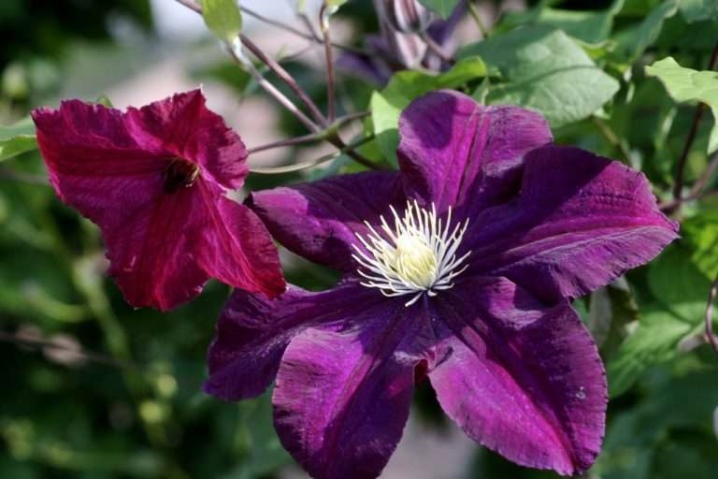
By the type of pruning, clematis are divided into three groups, depending on which shoots flowering on. Let's dwell on the third group of clematis.
Peculiarities
For the central part of Russia, the cultivation of clematis is most suitable for the third pruning group. Of all three groups, these are the most unpretentious plants. They are undemanding to the composition of the soil, location. They withstand periods of drought, are not afraid of severe frosts with minimal shelter. Flowers of the third group of clematis appear from mid-summer to early September only on the shoots of the current year. Last year's shoots remain without buds. Means, it makes no sense to leave long lashes for the winter, they will not bloom.
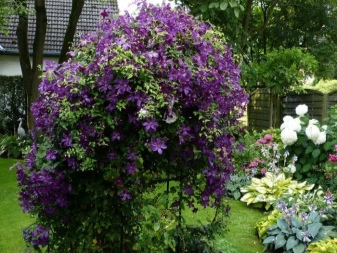
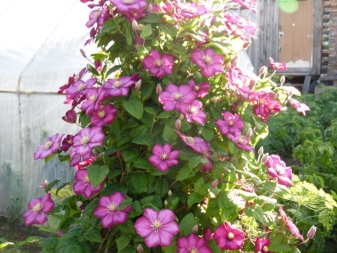
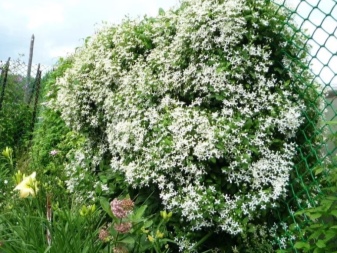

The goal of the gardener: to stimulate the formation of as many young shoots as possible in the spring. To do this, it is necessary to cut the clematis very shortly before sheltering for the winter, after the first frosts, leaving shoots no longer than 40 centimeters. Then you should spud the base of the bush with earth, cover it with humus, straw or rotted leaves on top. The scourge left on the surface it is advisable to cover for the winter with cardboard boxes or spunbond.

Clematis covered in this way, and even covered with snow, will perfectly survive the winter months and in the spring will be healthy, quite viable and ready to give many new young shoots.
Overview of species and the best varieties
There are a large number of types of clematis of the third pruning group. Let's take a look at some of them.
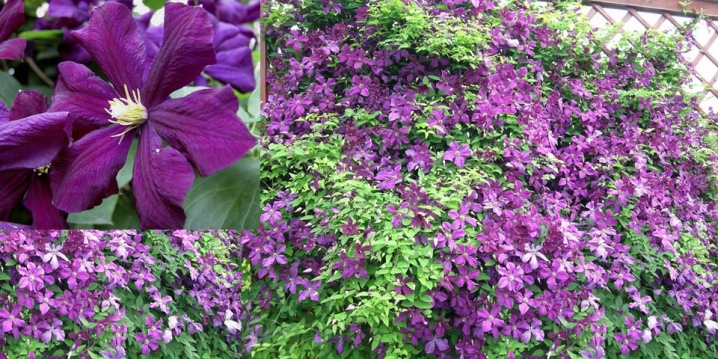
Clematis Jacques
This is perhaps the most spectacular type of the third group of clematis. It includes tall varieties up to six meters long. Flowers are odorless, of the most varied colors, very large, up to 20 cm in diameter. The best varieties are worth describing.
- "Blue flame" - truly the king among clematis. This is one of the most unpretentious and winter-hardy varieties, growing well from the Urals to the Moscow region. It blooms from July to September with gorgeous huge bright blue-purple flowers.
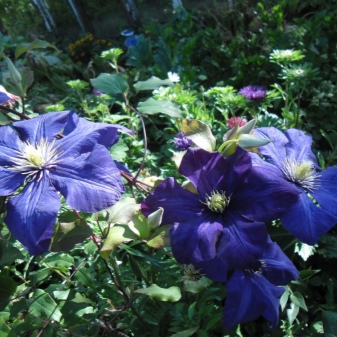
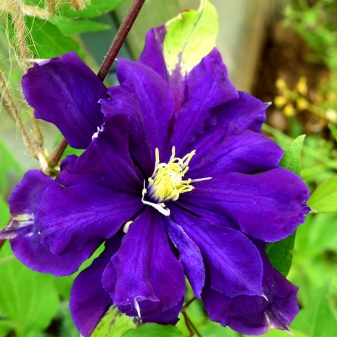
- "Nikolay Rubtsov" - clematis chameleon. It blooms with bright lilac flowers, then a lighter stripe appears in the center of each petal. Burns out over time. Depending on the weather conditions, the flowers are rich lilac or pale pink. To admire the more saturated color of this clematis, it should be planted in an area shaded from the bright sun.

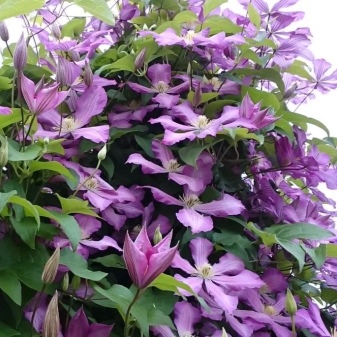
- "Rakhvarine" Is a very beautiful late flowering variety bred in Estonia. Its very wide petals, slightly overlapping each other, wavy at the edges, gracefully curl down at the very tips. The flowers of this clematis are velvety, purple in color with a darker stripe in the center. It blooms from late July to October.Unlike most plants in the Jacquemann group, it does not grow long. Its shoots are only two meters long.
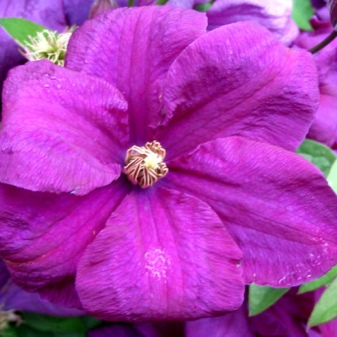
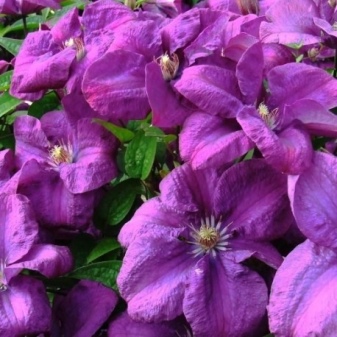
- "Bella" - an unusual variety for Zhakman's clematis, characterized by snow-white flowers that densely cover a low (up to two meters) liana. This clematis can be planted against the background of a shrub with dark leaves, which will create a contrast between the green and the whiteness of the flowers. "Bella" is unpretentious, tolerates forty-degree frosts.
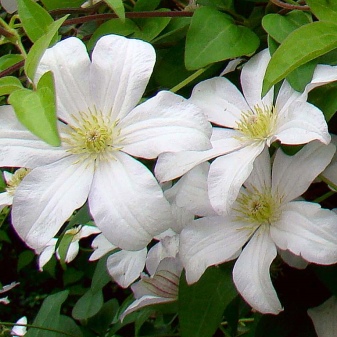
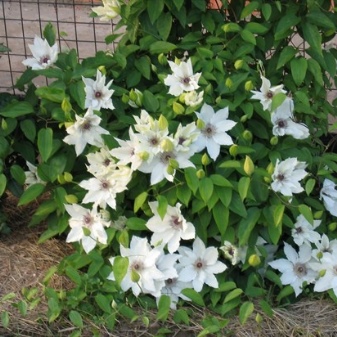
- "Victoria" - this variety was bred in Great Britain in 1867. The flowers are large, up to 19 cm in diameter, rich lilac color with a darker middle. The petals overlap and curl slightly at the edges. It blooms for about a month, no re-flowering is observed.
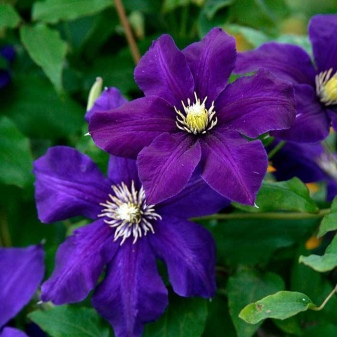
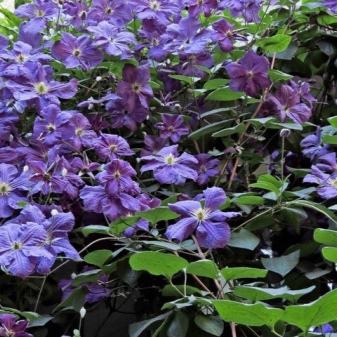
He is not afraid of low temperatures in winter, and if he freezes, he will recover very quickly. This variety is suitable for growing in the northern regions.
Clematis Viticella
This group brings together abundantly flowering and fast growing varieties. Flowers of red and purple shades, large. This group includes many varieties.
- "Ville de Lyon" - as the name implies, this variety was bred in France. It blooms very profusely with medium-sized (up to 13 cm) carmine-red flowers. Shoots up to 3 meters long. The variety is prone to fading.
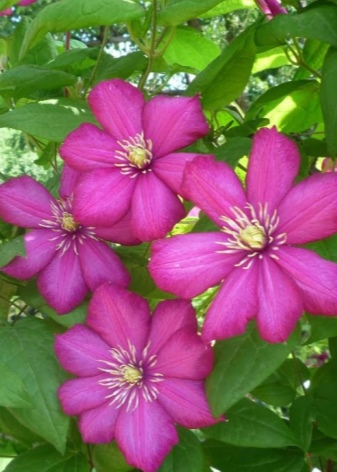
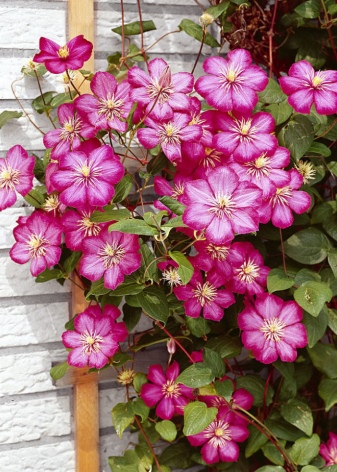
- "Purpurea Plena Elegance" - this variety is also bred in France. This clematis does not bloom for long: only a month, but this is compensated by the extraordinary beauty of the bush. It is so densely strewn with medium-sized (5–6 cm) double pink flowers that behind them no shoots with leaves are at all visible.
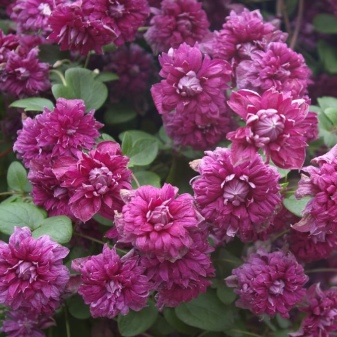

- "Etual Violett" - a wildly growing liana. It blooms with deep purple flowers. To emphasize the beauty of this clematis, it is recommended to plant it against the background of light walls and fences.
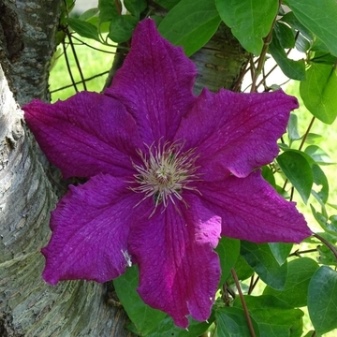
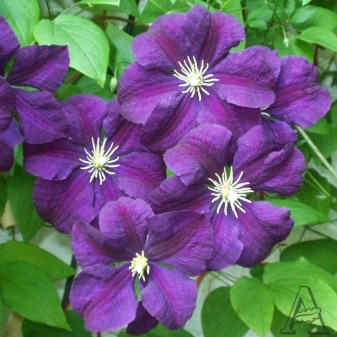
- "Dark Ayes" - the work of German breeders. It attracts attention with its dark purple-violet petals. The flowers are small, they will look favorably against the background of a white wall.

- "Nikitsky Pink" - obtained as a result of crossing "Ville de Lyon" and "Woolly Clematis". This variety is distinguished by flowers of a regular rounded shape with even petals of a pale pink color. It blooms in June. After flowering, you can cut off the shoots by a third. In this case, the clematis will bloom again, but not so abundantly.

Clematis Integrifolia
These are herbaceous shrubs, up to one and a half meters high. They do not have the ability to cling to a support, so they require a garter or growing as a groundcover. The flowers are drooping, bell-shaped. All clematis of this species are quite unpretentious, withstand severe frosts even without shelter. This group includes a wide variety of varieties.
- "Alyonushka" - a very unusual variety of clematis with pink bell flowers with beautifully curved wavy petals. It blooms very profusely, is not afraid of severe frosts, and is unpretentious.
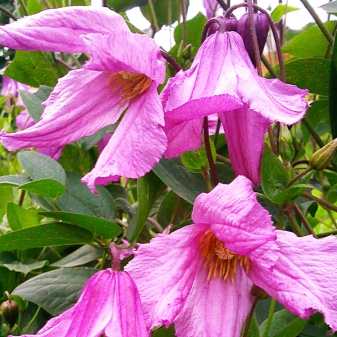
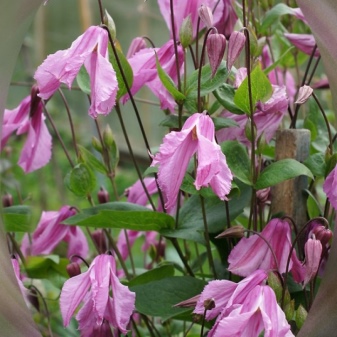
- "Blue River" - a variety bred in Holland. The length of the shoots does not exceed two meters. The flowers are medium-sized, blue, and then blue when dissolved.
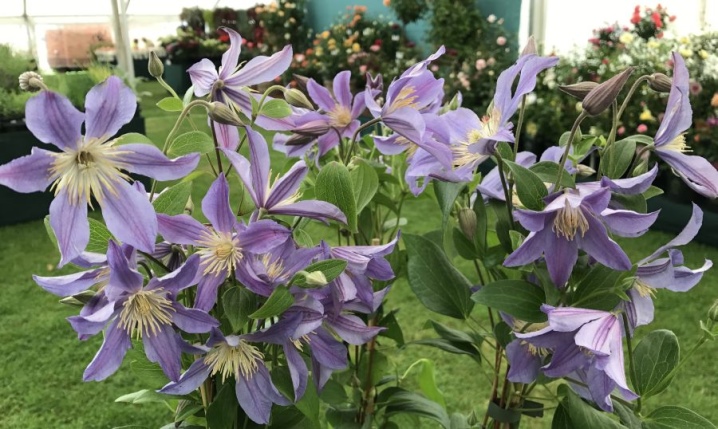
- "Inspiration" Is also a Dutch variety. It blooms with medium-sized red flowers with wavy petals. If you provide him with a sunny place, he will thank him with abundant flowering. In partial shade, it may not bloom at all. Responds gratefully to feeding.


- "Sapphire Indigo" - this is also a variety blooming with bell-shaped flowers, but, unlike the previous variety, they are more open and curved in different directions. It grows slowly, reaching one and a half meters. This variety blooms for a very long time (June - late September) with deep purple flowers.
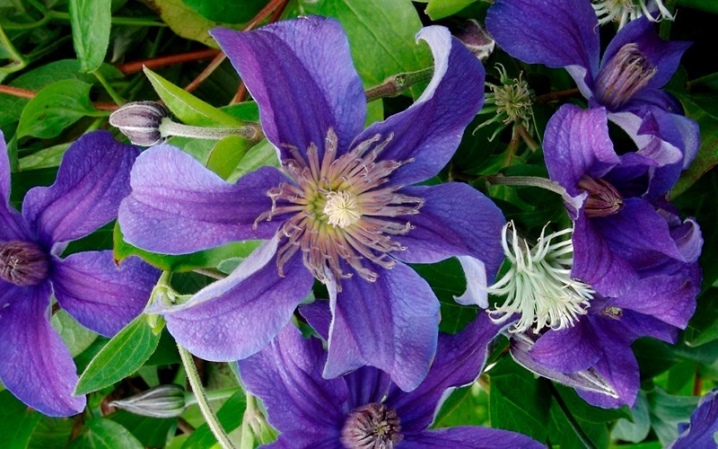
- "Hanayama" - an alien from Japan. An unusually decorative miniature bush, barely reaching seventy centimeters. It blooms with small (3-4 cm) pink flowers with a light border. It can be used as a curb plant, but be sure to tie it up, since the bushes, falling apart, lose their decorative effect.

- "Memory of the Heart" - this variety was bred in Ukraine. It is distinguished by drooping bell-shaped flowers with pale purple satin petals. This variety blooms from July to October.

Small-flowered clematis
This group includes a wide variety of varieties - both creeping and tall with a variety of colors of fragrant flowers. All clematis of this group are unpretentious, do not require shelter for the winter, and are easily propagated by seeds. This group also includes different varieties.
- "Clematis Straight" - so named because of the vertical arrangement of the buds. It is a shrub clematis reaching only 1 meter in height. The smell of its white flowers is sharp, sometimes even unpleasant.

- "Clematis purple" - a magnificent openwork slow-growing clematis, reaching five meters in length, branches well. All summer long it is densely strewn with small light purple flowers, completely undemanding to the conditions of detention.

You don't need to cover it for the winter. Even if part of the shoots freezes in a harsh winter, it will quickly recover.
- "Clematis of Tangut" - an unusual variety of clematis, distinguished by beautiful bright yellow lantern flowers. It does not bloom very abundantly, but for a long time: from mid-summer to late autumn. He loves sunny places. The length of the lashes reaches 6 meters.
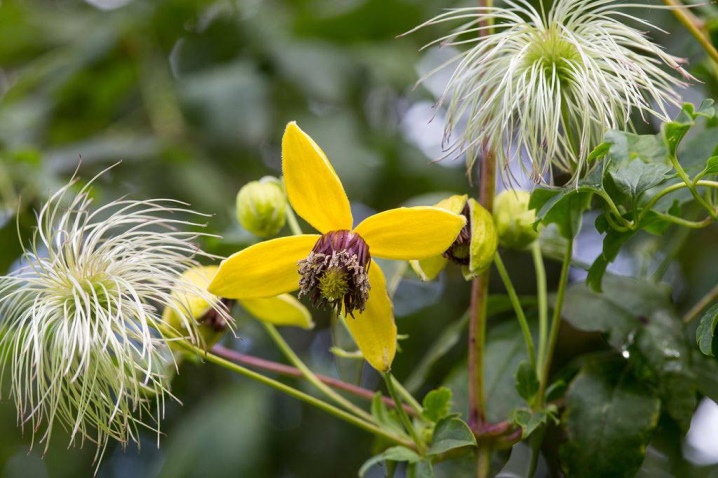
- "Clematis Manchu" - quite picky about lighting. Shoots grow no more than 4 meters in length. It has flowers of light shades, fragrant. This is a very unassuming plant, easily tolerates drought, but does not like the wind.
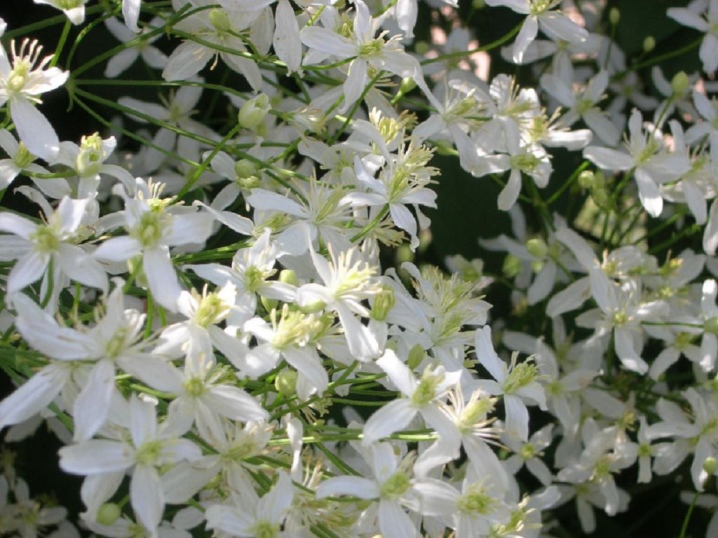
Texensis
These clematis have amazingly shaped drooping flowers, similar to tulips. Among the most common varieties, several are worth highlighting.
- Duchess of Albany - bright pink flowers with a crimson stripe in the middle of each petal. He prefers sunny or semi-shaded places, takes root for a long time. It requires very good shelter for the winter.
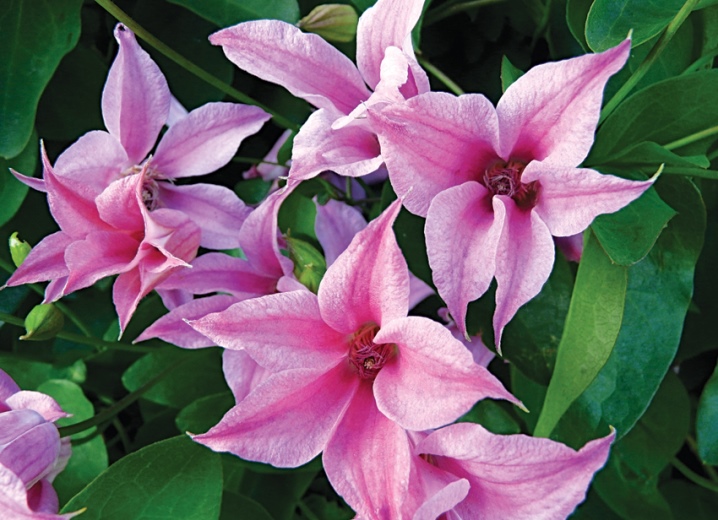
- "Princess Diana" - blooms for a short time (August – September) with deep pink flowers that attract the eye in the autumn garden. He loves bright places, does not tolerate harsh winters.
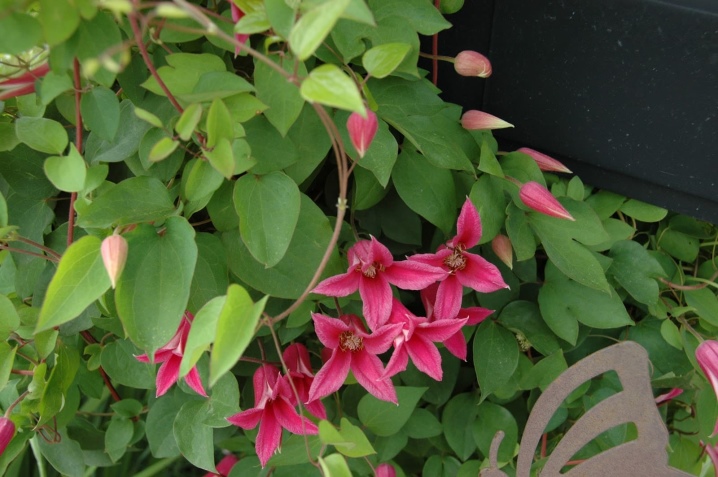
- "Gravy Beauty" - from late summer to early autumn, it pleases with its bright red medium-sized flowers in the form of lily-colored tulips. It is good to plant this clematis on a lilac or juniper bush, in which case you get the effect of a flowering tree.

Planting tips
Clematis of the third pruning group are easily propagated by cuttings. But in order for the bush to develop well, it is necessary to choose the right place for planting. Most of all clematis love to grow in sunny places, but content in partial shade is allowed. They will feel good in full shade, but in this case they will not please with their flowering. When planting clematis in a sunny area, it is advisable to make sure that their "legs" are hidden in the shade. To do this, at the base of the bush, you can plant low annual plants.
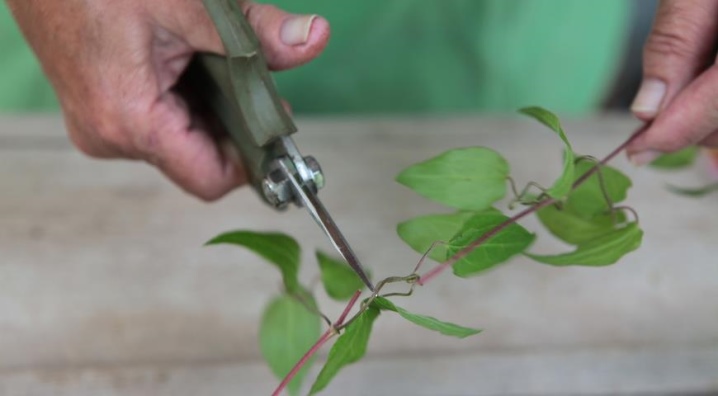
Avoid planting clematis in open, heavily wind-blown areas. The wind causes irreparable damage to the plant. And also it is not necessary to plant clematis in places where water stagnates: in lowlands, near drains. Clematis lives for a long time: 25-30 years, so the choice of a site for planting must be approached with great care. You can plant clematis throughout the season, but it is best to do this in the spring, so that the plant has time to take root and subsequently overwinter well.
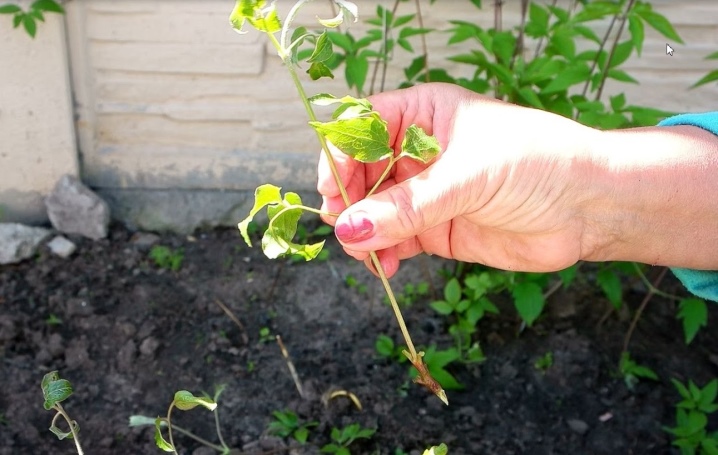
For each clematis, you need to dig a planting hole 50 centimeters deep and wide. At the bottom of this pit, place a layer of broken brick, pebbles or expanded clay, thereby providing the plant with drainage. As mentioned above, clematis do not like constant soil moisture, therefore the earthen mixture must be prepared especially carefully.
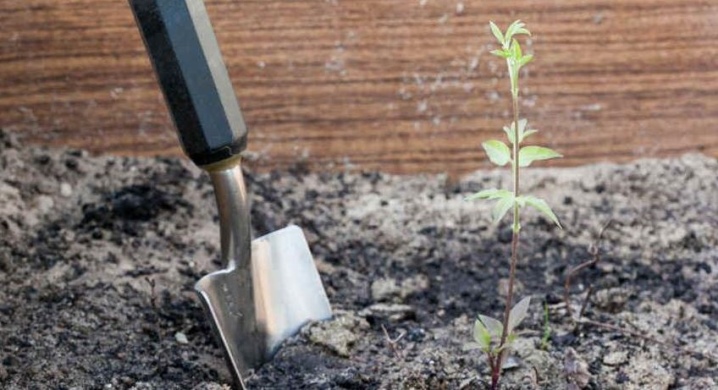
It should be lightweight, breathable and nourishing. To do this, mix peat, manure, sand and garden soil in equal proportions, add one hundred grams of fertilizer for clematis and a liter of ash.
Plant by gently spreading the roots. The root collar must be sprinkled with sand to prevent decay. Lomonosov must be planted with a shallow depth (up to 15 centimeters) for the subsequent formation of a lush bush, as well as to prevent winter freezing and summer overheating. When planting several seedlings the distance between them should be no more than one meter.
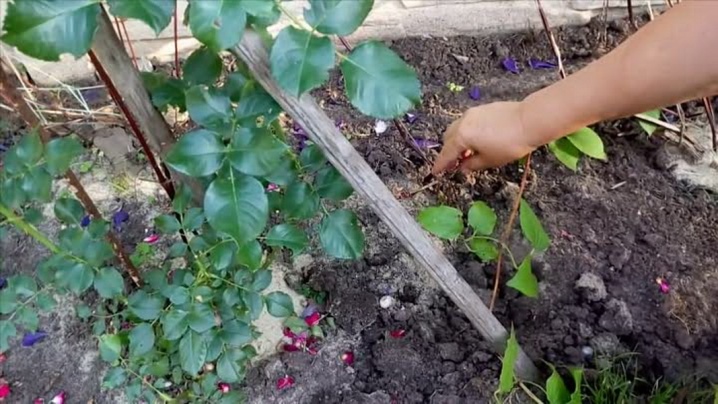
Care rules
It is quite easy to care for a planted plant.
- You need to ensure regular watering. Watering is necessary once a week abundantly, soaking the soil 30-50 cm. After a day or two, if the planting is not mulched, the soil must be loosened.
- Fertilizers can be given to Clematis in the second year after planting. To build up the green mass, nitrogenous, during the budding period and after flowering - phosphorus-potassium. Clematis responds well to feeding with infusion of mullein or chicken droppings.
- It is necessary to remember about the autumn pruning of clematis, since we are talking about the third group of these plants. Those varieties that winter poorly should be covered in late autumn.
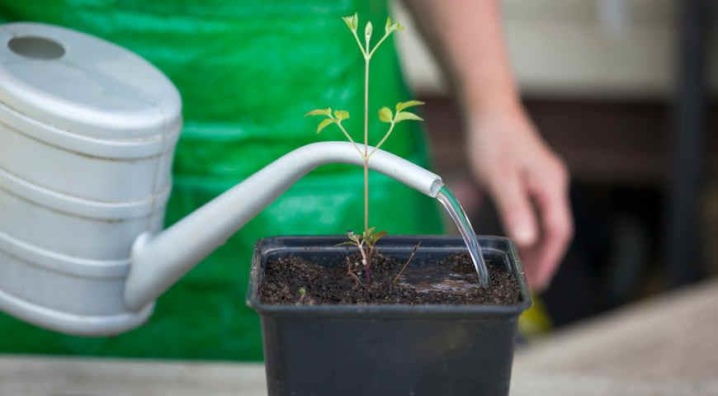
Examples in landscape design
The variety of forms and types of clematis allows it to be widely used in landscape design both as a lonely growing plant and as a background for other plants.
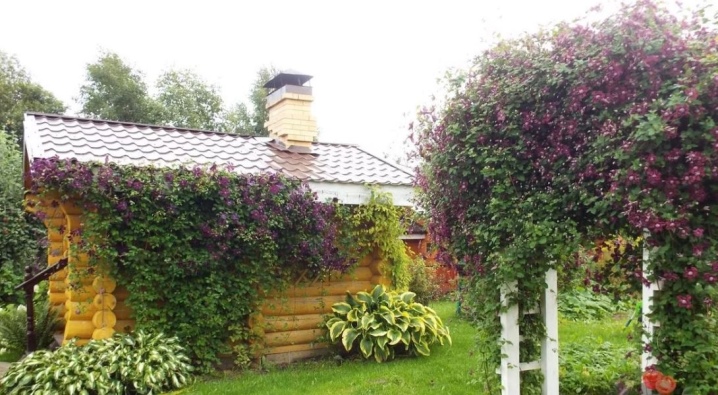
Tall, flowering varieties of clematis are used to decorate arches, arbors, walls, hedges. Clematis looks original, entwining a coniferous plant and blooming on it. Alpine slides, stone gardens, fences are decorated with ground cover species.

Clematis of the third pruning group are perfectly combined with other ornamental plants: daylilies, peonies, marigolds, morning glory, sweet peas and others.

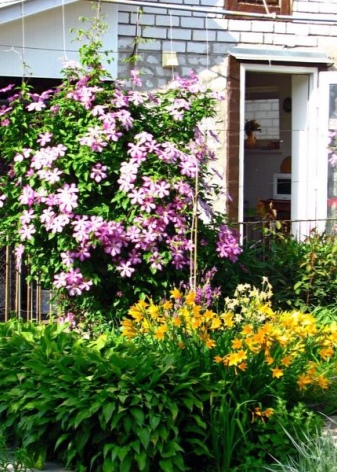
In areas with a classic arrangement of plants, it is best to combine clematis with roses, both of similar shades and contrasting ones. With climbing roses, it is better to plant clematis of the Jacqueman and Viticella groups. And with bushy plant low-growing varieties of the integrifolia species.

For information on how to properly care for clematis of 3 trimming groups, see the next video.







































































































The comment was sent successfully.